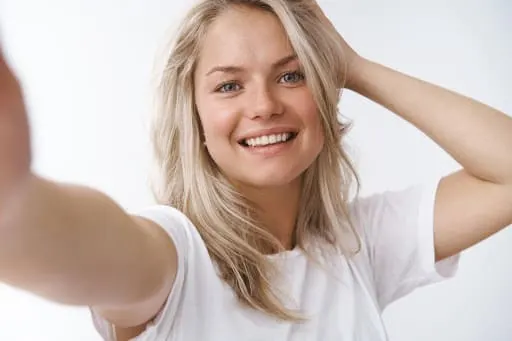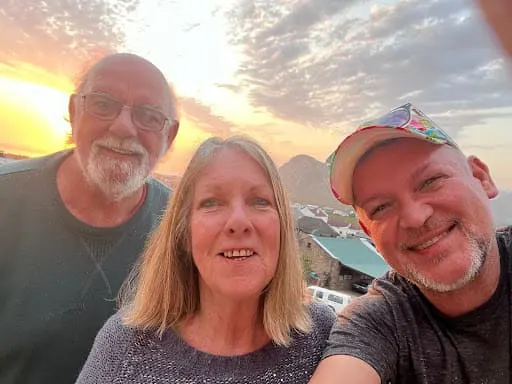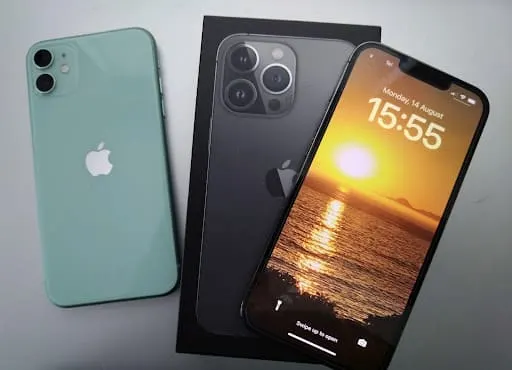The idea of self-portraiture – taking a photograph of yourself appeals to many of us, especially for social media use. Fortunately, it gets easier and easier because smartphones have unlocked the potential for us to include selfies in our photographic repertoires without special skills or equipment.
But of course, selfies don’t only mean self-portraiture, even though a typical definition states that it is “an image of oneself.”
In reality, many so-called selfies feature groups of people together but taken by someone in the group. In pedantic terms, it would then be a selfie of the person taking the picture. Also, often when we take selfies, we focus on ourselves but with other people in the background.
In general terms, smartphones have opened the doors of opportunity for many people who never dreamed of being able to take top-quality photographs, including portraits.
While professional photographers have equipment and skills that we will never equal smartphone cameras, there is no disputing that some smartphone cameras produce top-quality results many pros would be proud of. That might sound odd, but it’s true!
While there’s no denying that the arm of the hand that holds the camera commonly gets in the way of the pic, does it matter?
It does if you’re hoping to take great selfies with a smartphone. But if you can’t avoid it, you can often crop the offending arm out of the pic later.

V for victory or simply success. Here, the girl taking a selfie is in focus, but her background isn’t. See Focus Point below. Also, her arm enters the frame, making her look slightly uncomfortable. But it’s a fun selfie that can be cropped on the left.
So, how can we take great selfies with a smartphone?
First, you’re going to need a smartphone with a decent camera. Then you’re going to have to learn some basic photographic selfie skills. It’s that simple. I will talk about skills first because they are essentially the same for any smartphone you use. And I’m going to assume you know how your camera works.
Does Composition Matter When Taking a Selfie?
Composition always makes a difference when you take photographs. It means combining certain elements in your picture to get the best effect. But it’s not always easy when composing and taking a picture.
How you compose a pic also depends if you want to show your friends where you are and what you are doing, which is the aim of many selfies taken for social media.
I will keep it simple and give you pointers for the format, framing, subject placement, balance, and the proven rule of thirds.
Format
This means you decide whether to shoot your selfies in a portrait or landscape format. Portrait is an obvious choice if it’s a selfie of you alone. The landscape is often a better choice if other people are in the pic or if you want to include the landscape behind you.
Additionally, some cameras (including later iPhones) have a portrait mode. Rather than focusing on format, portrait mode recognizes faces and picks up more detail. It’s ideal for selfies.

A landscape format is an obvious choice for this selfie because it shows the environment, a boat, and water. She’s managed to keep her arm looking relatively natural, but her finger is across the lens. While the pic can be cropped, it’ll lose some water and end up less of a landscape shot than intended. In this situation, it’s best to take multiple photos so you can choose at the end of the day. And keep your fingers out of your picture!
Framing
It’s best to fill the frame with your subject in portrait photography. In the case of a selfie, this will be you or you and those you are posing with. A portrait format is usually best for only you, but the landscape often works better when multiple people exist.
To make the best of framing, you can use objects and surrounding elements to frame the selfie.
For example, you can position yourself so that a window frame literally frames you. Or you can use landscape elements, like tree branches or arched structures, to create a frame around you. Alternatively, you can fill the frame.

Subject Placement
Even though framing yourself in the center of a pic can work very well when taking great selfies with a smartphone, there are times when you might want to be off-center. For example, show people where you are. But when you place yourself off-center, you must also consider focus.
Generally, a smartphone will set the exposure and focus automatically. But some smartphones, including iPhone 11 and later models using iOS 14 or later, allow you to adjust your exposure level and focus.

A selfie is taken so that the background is clearly evident, even though it is out of focus. This particular pic would be easy to crop naturally if you didn’t want your arm to be so obvious.
Rule of Thirds
The rule of thirds is one of the essential elements of a good photograph. But it’s not easy to get it right when taking spontaneous selfies. And if you want to fill the frame when taking a selfie, it will be completely irrelevant.
The idea is fairly simple.
When you focus your smartphone camera on a subject, imagine two vertical and two horizontal lines placed equally apart. This creates an imaginary grid of nine equal squares. You can use this to divide up the elements you are shooting.
The pic of the girl in a boat (above) uses the rule of thirds.
She’s framed herself in the center of the pic, with the boat in the bottom third and the landscape along the top horizontal line. But you don’t have to be in the center of the photograph for it to work.
You can place yourself in any of the center or bottom squares. Also, you might position the horizon in the center rather than along the top line.
Why not give it a try?
Consider Your Background
You can often get in quite tight when taking a selfie, but sometimes the background matters. If it isn’t necessary, instead, find a relatively plain background. Alternatively, choose a natural setting that won’t detract from your image.
Ultimately, unless you want to focus on or show off your background, you won’t want it to detract from you or the group you are snapping. The selfie under Framing is a good example of a plain background.
The Importance of Balance
Balance can play an important role when taking great selfies with a smartphone. But it’s a subjective technique, and professional photographers will tell you they often like to ensure their photographs are deliberately composed with unequal balance.
One way to use balance when taking selfies is to frame yourself with something on either side of you.
This could be two pot plants, pillars, or even two friends. This technique also minimizes elements in the background that might be distracting.

A nicely balanced selfie with a relatively neutral background.
The Effect of Lighting on Your Selfies
Lighting is one of the most essential elements of professional studio photography. But good lighting makes a difference in any situation. Think of trying to take a picture of your garden on a sunny day when half is in the shade.
It’s not going to work.
If you try to take a picture of somebody with the sun behind them, it’ll create shadows on their face, and you’ll lose the detail of their features.
The same applies to selfies.
You can take great selfies with a smartphone indoors and outdoors, provided the lighting is proper. If you are indoors during the day, you don’t want to position yourself near a door or window where the sunlight is streaming in. It will tend to blast out your picture. At night, stand away from overhead lights. It’s not difficult to find a suitable position … move until you are sure no beams of light impact your selfie.
When taking a selfie outdoors, it’s usually best to find a partially shaded area without direct sunlight. Direct sunlight can create ugly shadows under your eyes that aren’t going to do you justice.

Here’s a “selfie” we took recently with my iPhone 13 Pro. It was a stunning evening, and the sun was setting. Additionally, the white building in front of us reflected the setting sunlight back to our faces. My arm kept getting in the way, so my mate grabbed the phone and took the shot. The backlighting of the fast-disappearing sunset works beautifully. It’s just a pity that his finger covered the top corner of the lens.
Where to Look & How to Sit When Taking a Selfie
When somebody else takes a photograph of you, unless you want to gaze into the distance deliberately, it’s best to make eye contact with the camera lens rather than the photographer. Taking a great selfie can be disconcerting but usually improves with practice.
Taking selfies from different angles is also a good idea, which I wrote about in my “9 Awesome Phone Selfies Tips For Guys” article.
Try tilting your head or looking down at the camera.
Also, pay attention to posture. Stand up straight with your shoulders pulled back. Smile. If you don’t want your teeth to show, try a close-mouthed smile – whatever works best for you.

A big, confident smile goes a long way when taking great selfies with a smartphone.
What’s the Best Smartphone for Taking Selfies?
Whether you are in the market for a quality camera with interchangeable lenses, a single lens reflex camera (SLRC), or a smartphone that takes great selfies, you must research to find out which will meet your needs.
Nowadays, there are so many smartphone options on the market that it’s almost impossible to gauge which is the best smartphone for taking selfies without doing a hands-on trial of some of the best.
But some of those that constantly top the “best” lists include Apple iPhones, Samsung Galaxy models, Google Pixel mobile phones, and Sony Xperia. We’re not comparing features in this post, but I will mention a few that work particularly well for people who want to take great selfies with a smartphone.
Apple iPhones
If you are an Apple fan, nothing anyone says will change your mind. That’s me. But I must say that you need to look carefully at the model you buy. Some iPhones do the selfie job better than others. And it’s not rocket science to realize that newer models are more likely to produce better results than older ones.
I’ve been using iPhones for as long as I can afford them.
I think it was probably the iPhone 5 I first used for selfies. But Apple has upped their game so much that there is no comparison to these results compared to the iPhone 11 and, more so, the iPhone 13 Pro I now use.
By all accounts, the iPhone 14 Pro is yet another game-changer. But don’t be intimidated. You don’t have to buy the newest and best. Buy what you can afford. Just be aware of what your new smartphone camera offers.

For example, the iPhone 11 (left) has a dual-camera system incorporating wide and ultra-wide lenses.
The iPhone 11 Pro has a triple rear camera. The iPhone 12 has two cameras in a vertical line, and the iPhone 13 has two lenses placed diagonally. The iPhone 13 Pro (right) has three telephoto, wide, and ultra-wide cameras.
But here’s the rub: despite the other camera differences, the iPhone 13 front camera is much the same as the 11.
The camera design of the iPhone 14 is similar to the 13 models, although some reviewers are dubbing it the world’s best selfie phone! That’s largely because they’ve upgraded the front-facing camera module, which is used for taking selfies.
Samsung Galaxy Models
Samsung, a South Korean company, manufactures excellent Android smartphones that have cameras known to take great selfies.
There are a lot of choices too.
For instance, the Samsung Galaxy S23 Ultra has a selfie camera lens that helps eliminate flare and other features, making it one of the best-selling smartphones for taking great selfies.
The Samsung Galaxy S22 is another good model for selfies, and it has a superb zoom lens. The A14 5G is another model that works well for selfies because of its high-quality front camera.
Some Smartphone Options from China
Two of the top choices from China are the 2019 Huawei Y9 Prime and the later Honor 50 Lite. The Huawei Y9 Prime has three rear cameras, the main one, an ultrawide one designed for depth, and a front-facing, pop-up camera designed especially for selfies.

Regarded as a budget smartphone, the Honor 50 Lite is considerably cheaper than the Huawei Y9, but amazingly, its cameras are superior.
There are four rear cameras, a primary camera, a wide angle, a depth, and a 4 cm macro camera. It also has a remarkably good front camera, ideal for taking great selfies.
Interestingly, the Honor smartphone brand was formerly owned by Huawei, but they sold it to a state-owned enterprise in 2020.
So Where to From Here?
Ultimately, whichever device you choose, trial and error will be a good teacher for mastering how to take great selfies with a smartphone. Practice on your own as much as you can.
Take selfies in different environments and play around with the tips and ideas we have mentioned.
It doesn’t matter if some of the pix you take are less than complimentary, you can trash them, and nobody else will ever see them unless you want them to.
Also, remember that some of the best selfies are those we take spontaneously.
Very often, these are the ones we treasure most because of the memories they have instilled in us. But, of course, if you are taking a self-portrait selfie that you will use for social media or perhaps for a resume or something similar, you will need more precision and attention to detail.